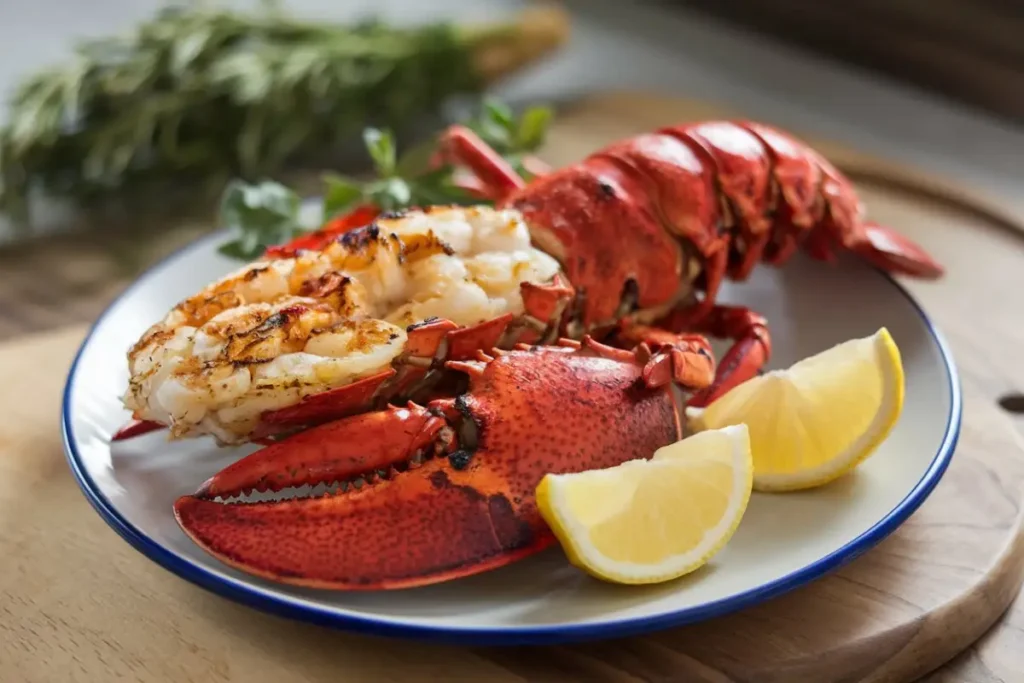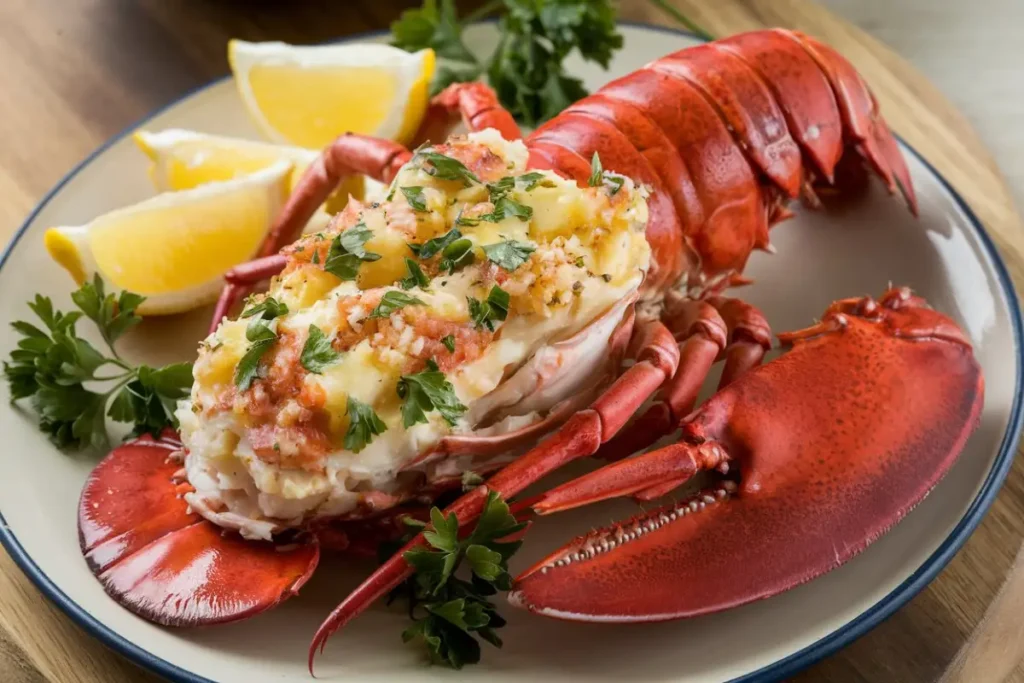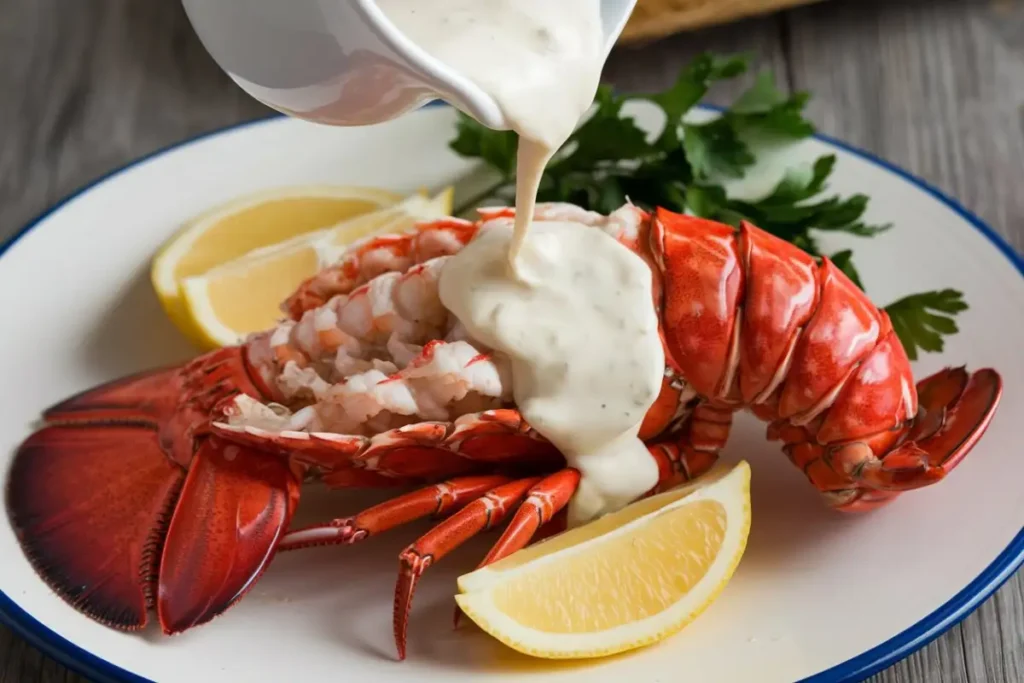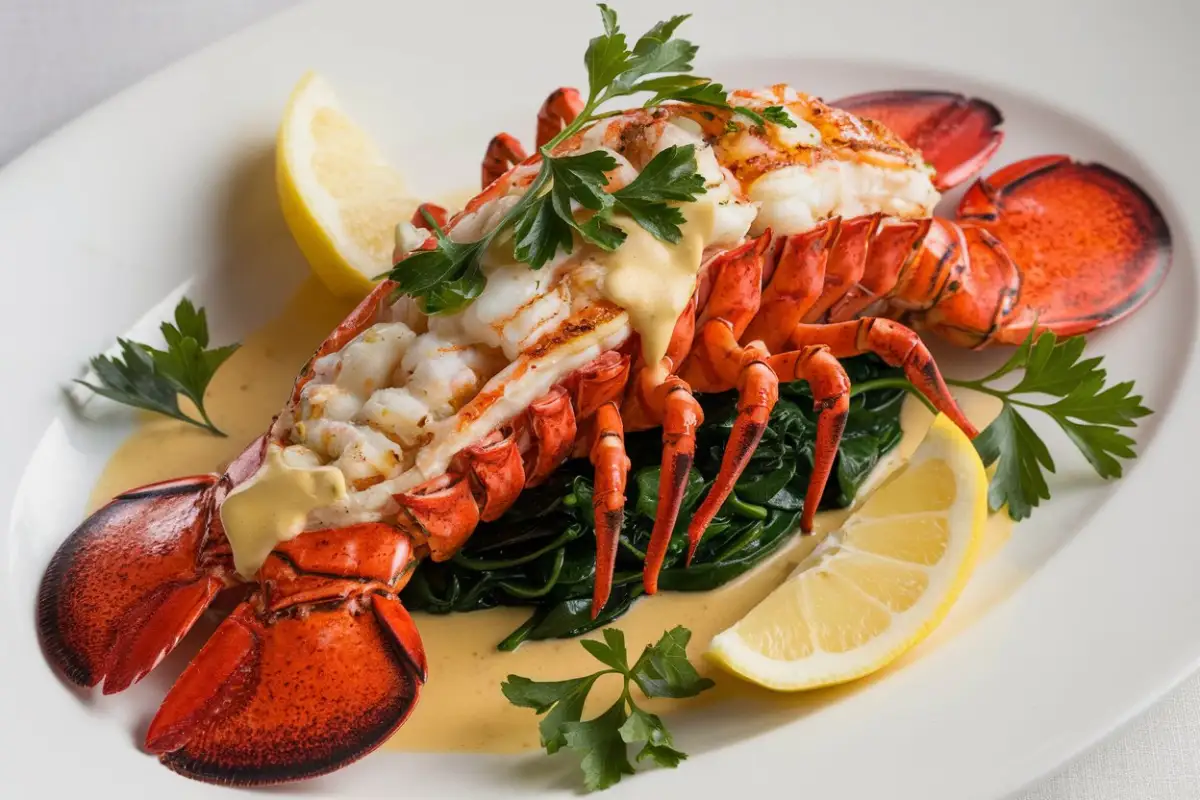Lobster tail recipes are the ultimate way to enjoy gourmet seafood at home. Whether you’re a beginner or an experienced cook, these easy lobster tail recipes will guide you step by step to create mouthwatering, restaurant-quality meals. From broiled and grilled to baked and pan-seared options, you’ll discover a variety of lobster tail recipes that highlight the rich, delicate flavors of this luxurious seafood.
Indulge in the Luxury of Lobster Tail: A Brief History
Believe it or not, lobster wasn’t always considered a delicacy. Back in colonial times, it was so abundant that it was often used as fertilizer or even prison food! Can you imagine? But as times changed and seafood became more sought after, lobster gradually climbed its way up the culinary ladder, eventually becoming the symbol of luxury we know and love today. The tail, specifically, gained popularity for its concentrated meat and ease of preparation.
Nutritional Benefits of Lobster Tail: More Than Just a Treat
Okay, let’s be real we eat lobster tail because it tastes amazing. But did you know it’s also pretty good for you? This succulent seafood is packed with protein, which is essential for building and repairing tissues. It’s also a great source of selenium, a powerful antioxidant that helps protect your cells from damage. Plus, it’s relatively low in fat and calories, making it a guilt-free indulgence.
“Lobster is a great source of lean protein and essential nutrients. Enjoy in moderation as part of a balanced diet!” Dr. Seafood Expert, Marine Nutritionist.
Decoding the Lobster Tail: Anatomy and Choosing the Best
Before we get into the recipes, let’s talk lobster tail 101. Understanding what you’re working with and how to select the best ones will make all the difference in your final dish.
Lobster Tail Anatomy 101: Understanding the Parts
A lobster tail, as the name suggests, is simply the tail section of the lobster. It consists of a hard shell that protects the tender, meaty flesh inside. The fan-like end of the tail is used for swimming, and the underside contains the veins we’ll need to remove during prep. Knowing these basics will help you navigate the cooking process with confidence. Think of it as getting to know your ingredients intimately!
Fresh vs. Frozen: Making the Right Choice
Ah, the age-old debate! Fresh lobster tail is undoubtedly the gold standard, offering the best flavor and texture. However, it can be harder to find and more expensive. Frozen lobster tail, on the other hand, is readily available and often more budget-friendly. The key is to buy high-quality frozen tails from a reputable source and thaw them properly (more on that later!). Honestly, a properly thawed and cooked frozen lobster tail can be just as delicious as fresh!
Size Matters: Selecting the Perfect Lobster Tail Size for Your Meal
Lobster tails come in various sizes, typically measured in ounces. A 5-6 ounce tail is generally considered a good portion for a single serving, while larger tails (8 ounces or more) are great for sharing or for heartier appetites. Consider the other dishes you’ll be serving when deciding on the size. Are you planning a multi-course meal, or is the lobster tail the star of the show?
Essential Cooking Techniques for Perfect Lobster Tail Recipes
Cooking lobster tail to perfection requires mastering a few essential techniques. Whether you’re broiling, grilling, baking, or pan-searing, the right method ensures that your lobster remains tender, flavorful, and juicy.
If you’re looking to improve your overall cooking skills, Master the best cooking techniques for meat and seafood and explore how different flavors, seasonings, and methods can enhance your culinary creations.
Thawing Frozen Lobster Tails: The Safe and Effective Methods
This is not a step you want to skip or rush! Never, ever thaw lobster tails at room temperature. This can lead to bacterial growth and a less-than-desirable result. The best way to thaw them is in the refrigerator overnight (or for about 24 hours). Place them in a sealed bag or container to prevent them from drying out. If you’re short on time, you can thaw them in a cold water bath, changing the water every 30 minutes. But be sure to cook them immediately after thawing using this method.
Cleaning and Deveining: Getting Rid of Unwanted Grit
Okay, this part might sound a little gross, but it’s necessary. Lobster tails have a dark vein running along the back of the tail, which is basically their digestive tract. While it’s not harmful to eat, it can sometimes contain grit or sand, which can detract from the flavor. To remove it, use a sharp knife to make a shallow cut along the back of the tail, then gently pull out the vein. Rinse the tail under cold water to remove any remaining debris.
Butterflying vs. Cutting: Preparing Your Lobster Tail for Cooking
There are a couple of different ways to prepare your lobster tails for cooking, each with its own advantages. Butterflying involves cutting the shell lengthwise and gently separating the meat from the shell, leaving it attached at the tail end. This creates a beautiful presentation and allows the lobster to cook evenly. Cutting the tail completely in half is another option, especially if you’re grilling or pan-searing. It allows for maximum surface area contact with the heat, resulting in a crispy, flavorful crust. The choice is yours!
The 7 Best Lobster Tail Recipes: A Culinary Journey
Now for the fun part the recipes! I’ve curated a collection of my favorite lobster tail recipes, ranging from simple and classic to slightly more adventurous. There’s something here for everyone, so get ready to unleash your inner chef!
Broiled Lobster Tail: Simple Elegance in Minutes
Broiling is one of the quickest and easiest ways to cook lobster tails. It’s perfect for a weeknight dinner or when you’re short on time but still want something special. The key is to keep a close eye on the tails and avoid overcooking them.
Tips for Perfect Broiling: Avoiding Overcooking
- Preheat your broiler: Make sure your broiler is nice and hot before you put the lobster tails in.
- Position the rack: Place the rack about 6-8 inches from the broiler.
- Keep an eye on them: Lobster tails cook quickly under the broiler, so watch them carefully. They’re done when the meat is opaque and firm to the touch.
- Don’t overcook! Overcooked lobster is tough and rubbery. Nobody wants that!
Broiled Lobster Tail Recipes: Quick and Elegant Seafood Delights
Ingredients:
- 2 lobster tails (5-6 ounces each)
- 4 tablespoons butter, melted
- 2 cloves garlic, minced
- 1 tablespoon fresh parsley, chopped
- 1 tablespoon fresh chives, chopped
- 1/2 teaspoon lemon juice
- Salt and pepper to taste
Instructions:
- Preheat your broiler.
- Butterfly the lobster tails.
- In a small bowl, combine the melted butter, garlic, parsley, chives, and lemon juice. Season with salt and pepper.
- Brush the lobster tails with the garlic herb butter.
- Place the lobster tails on a baking sheet and broil for 5-7 minutes, or until the meat is opaque and firm.
- Serve immediately with extra garlic herb butter for dipping.
Grilled Lobster Tail: Smoky Flavor and Summer Vibes
Grilling lobster tails adds a delicious smoky flavor that’s perfect for summer barbecues. The key is to use medium heat and avoid overcooking the tails, which can make them tough.
Grilling Techniques for Tender Lobster Tail
- Medium heat is key: Don’t blast your lobster tails with high heat. Medium heat will cook them evenly without burning the shell.
- Oil the grill grates: This will prevent the lobster tails from sticking.
- Start shell-side down: This will protect the delicate meat from the direct heat.
- Baste with butter: Keep the lobster tails moist by basting them with melted butter throughout the grilling process.
Grilled Lobster Tail Recipes: Infusing Smoky Flavor for a Summer Treat

Ingredients:
- 2 lobster tails (5-6 ounces each)
- 2 tablespoons olive oil
- 1 tablespoon lemon juice
- 1/2 teaspoon chili flakes
- Salt and pepper to taste
Instructions:
- Preheat your grill to medium heat.
- Butterfly the lobster tails.
- In a small bowl, combine the olive oil, lemon juice, chili flakes, salt, and pepper.
- Brush the lobster tails with the lemon chili mixture.
- Place the lobster tails on the grill, shell-side down, and grill for 5-7 minutes.
- Flip the lobster tails and grill for another 3-5 minutes, or until the meat is opaque and firm.
- Serve immediately with lemon wedges.
Baked Lobster Tail: Tender and Flavorful Every Time
Baking is a foolproof way to cook lobster tails. It’s gentle and even, resulting in tender, flavorful meat.
Achieving Even Cooking in the Oven
- Use a baking dish: A baking dish will help to distribute the heat evenly.
- Add a little liquid: Adding a splash of white wine or broth to the baking dish will keep the lobster tails moist.
- Cover with foil (optional): Covering the baking dish with foil for the first half of the cooking time will help to prevent the lobster tails from drying out.
Baked Lobster Tail Recipes: Slow-Cooked Perfection for Maximum Flavor

Ingredients:
- 2 lobster tails (5-6 ounces each)
- 4 tablespoons butter, melted
- 1/4 cup grated Parmesan cheese
- 2 cloves garlic, minced
- 1 tablespoon fresh parsley, chopped
- Salt and pepper to taste
Instructions:
- Preheat your oven to 375°F (190°C).
- Butterfly the lobster tails.
- In a small bowl, combine the melted butter, Parmesan cheese, garlic, parsley, salt, and pepper.
- Spread the Parmesan mixture over the lobster tails.
- Place the lobster tails in a baking dish and bake for 12-15 minutes, or until the meat is opaque and firm.
- Serve immediately.
Pan-Seared Lobster Tail: Restaurant-Quality at Home
Pan-searing gives lobster tails a beautiful, caramelized crust and a succulent, tender interior. It’s a technique that requires a little practice, but the results are well worth the effort.
The Secret to a Perfect Sear: Achieving Caramelization
- Use a heavy-bottomed skillet: A heavy-bottomed skillet will distribute the heat evenly and help to create a beautiful sear.
- Get the skillet hot: Make sure the skillet is nice and hot before you add the lobster tails.
- Use high heat: Sear the lobster tails over high heat to get a good crust.
- Don’t overcrowd the skillet: If you’re cooking multiple lobster tails, do it in batches to avoid overcrowding the skillet.
Pan-Seared Lobster Tail Recipes: Restaurant-Quality Dishes at Home
Ingredients:
- 2 lobster tails (5-6 ounces each)
- 2 tablespoons olive oil
- 4 tablespoons butter
- 1/4 cup fresh sage leaves
- Salt and pepper to taste
Instructions:
- Butterfly the lobster tails.
- Heat the olive oil in a heavy-bottomed skillet over high heat.
- Season the lobster tails with salt and pepper.
- Sear the lobster tails, meat-side down, for 3-4 minutes, or until they are nicely browned.
- Flip the lobster tails and cook for another 2-3 minutes, or until the meat is opaque and firm.
- Remove the lobster tails from the skillet and set aside.
- Add the butter to the skillet and cook over medium heat until it browns and smells nutty.
- Add the sage leaves to the skillet and cook for 30 seconds.
- Pour the brown butter sage sauce over the lobster tails and serve immediately.
Poached Lobster Tail: For Ultimate Tenderness
Poaching is a gentle cooking method that results in incredibly tender and succulent lobster tails. It’s perfect for when you want to highlight the delicate flavor of the lobster without adding any harsh or overpowering flavors.
The Art of Gentle Poaching: Maintaining Moisture
- Use a low simmer: The water should be barely simmering, not boiling.
- Don’t overcook: Overcooked poached lobster is tough and dry.
- Add aromatics: Adding herbs, spices, or citrus to the poaching liquid will infuse the lobster tails with flavor.
Poached Lobster Tail with White Wine Reduction Recipe

Ingredients:
- 2 lobster tails (5-6 ounces each)
- 4 cups water
- 1 cup dry white wine
- 1 lemon, sliced
- 2 sprigs fresh thyme
- Salt and pepper to taste
- 2 tablespoons butter
- 1 shallot, minced
- 1/4 cup heavy cream
Instructions:
- In a large pot, combine the water, white wine, lemon slices, thyme, salt, and pepper. Bring to a low simmer.
- Add the lobster tails to the pot and poach for 5-7 minutes, or until the meat is opaque and firm.
- Remove the lobster tails from the pot and set aside.
- In a separate saucepan, melt the butter over medium heat.
- Add the shallot and cook until softened.
- Add the poaching liquid to the saucepan and bring to a simmer.
- Reduce the liquid by half.
- Stir in the heavy cream and simmer for another minute.
- Pour the white wine reduction over the lobster tails and serve immediately.
Air Fryer Lobster Tail: A Quick and Healthy Option
The air fryer is a fantastic way to cook lobster tails quickly and easily, with minimal added fat. It creates a crispy exterior and a juicy interior.
Air Frying Lobster Tail: Temperature and Timing Tips
- Preheat your air fryer: Make sure your air fryer is preheated before you add the lobster tails.
- Lightly oil the lobster tails: This will help them to crisp up nicely.
- Don’t overcrowd the air fryer: Cook the lobster tails in batches if necessary.
Air Fryer Lobster Tail with Everything Bagel Seasoning Recipe
Ingredients:
- 2 lobster tails (5-6 ounces each)
- 1 tablespoon olive oil
- 2 tablespoons everything bagel seasoning
Instructions:
- Preheat your air fryer to 400°F (200°C).
- Butterfly the lobster tails.
- Brush the lobster tails with olive oil.
- Sprinkle the lobster tails with everything bagel seasoning.
- Place the lobster tails in the air fryer and cook for 6-8 minutes, or until the meat is opaque and firm.
- Serve immediately.
Lobster Tail Scampi: A Classic with a Twist
Lobster tail scampi is a luxurious twist on the classic shrimp scampi. It’s a rich and flavorful dish that’s perfect for a special occasion.
Creating the Perfect Scampi Sauce
- Use plenty of garlic: Garlic is the key to a good scampi sauce.
- Don’t skimp on the butter: Butter adds richness and flavor.
- Add a touch of white wine: White wine adds acidity and complexity.
Lobster Tail Scampi with Linguine Recipe
Ingredients:
- 2 lobster tails (5-6 ounces each)
- 8 ounces linguine pasta
- 4 tablespoons butter
- 4 cloves garlic, minced
- 1/4 cup dry white wine
- 1/4 cup chicken broth
- 1/4 cup chopped parsley
- Salt and pepper to taste
- Red pepper flakes (optional)
Instructions:
- Cook the linguine pasta according to package directions.
- Butterfly the lobster tails.
- Melt the butter in a large skillet over medium heat.
- Add the garlic and cook until fragrant.
- Add the white wine and chicken broth to the skillet and bring to a simmer.
- Add the lobster tails to the skillet and cook for 5-7 minutes, or until the meat is opaque and firm.
- Stir in the parsley, salt, pepper, and red pepper flakes (if using).
- Add the cooked linguine to the skillet and toss to coat.
- Serve immediately.
For more recipes Follow me in Facebook and Pinterest
Common Mistakes to Avoid in Lobster Tail Recipes
Even with the best recipes, things can sometimes go wrong. Here’s how to troubleshoot some common lobster tail problems:
Tough and Rubbery Lobster Tail: Prevention and Solutions
This is almost always due to overcooking. Next time, try reducing the cooking time or using a lower heat. Soaking the lobster tail in milk for about 30 minutes before cooking might help tenderize it.
Undercooked Lobster Tail: Identifying and Rectifying the Issue
Undercooked lobster is translucent and mushy. If you realize it’s undercooked, simply put it back in the oven, broiler, or skillet for a few more minutes until it reaches an opaque color and firm texture.
Dry Lobster Tail: Maintaining Moisture During Cooking
Basting with butter or olive oil during cooking helps prevent dryness. You can also add a splash of liquid (wine, broth) to the cooking pan to create steam.
Overpowering Fishy Taste: Choosing Freshness and Proper Preparation
A strong fishy taste usually indicates that the lobster tail wasn’t fresh. Always buy from a reputable source and check the expiration date. Proper cleaning and deveining also help.
Shell Sticking to the Meat: Ensuring Easy Removal
This can happen if the lobster is overcooked or if you haven’t butterflied it properly. Make sure the lobster is cooked just until done, and use a sharp knife to carefully separate the meat from the shell.
Conclusion: Your Journey to Lobster Tail Mastery
Recap of Key Takeaways
From selecting the perfect lobster tail to mastering various cooking techniques, you’ve now got the knowledge and skills to create delicious lobster tail dishes at home. Remember to choose fresh or high-quality frozen tails, prep them carefully, and avoid overcooking!

